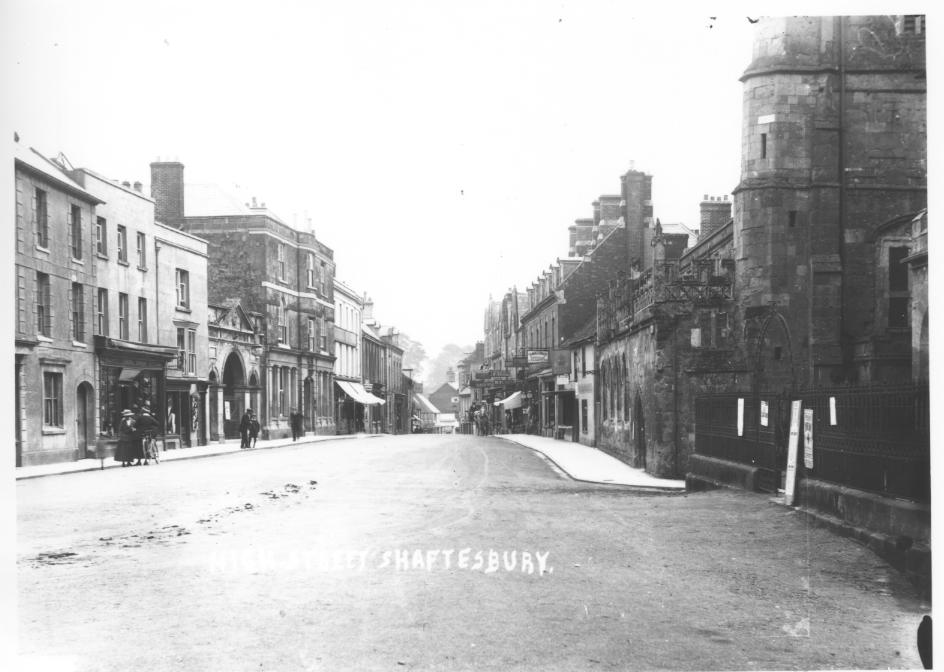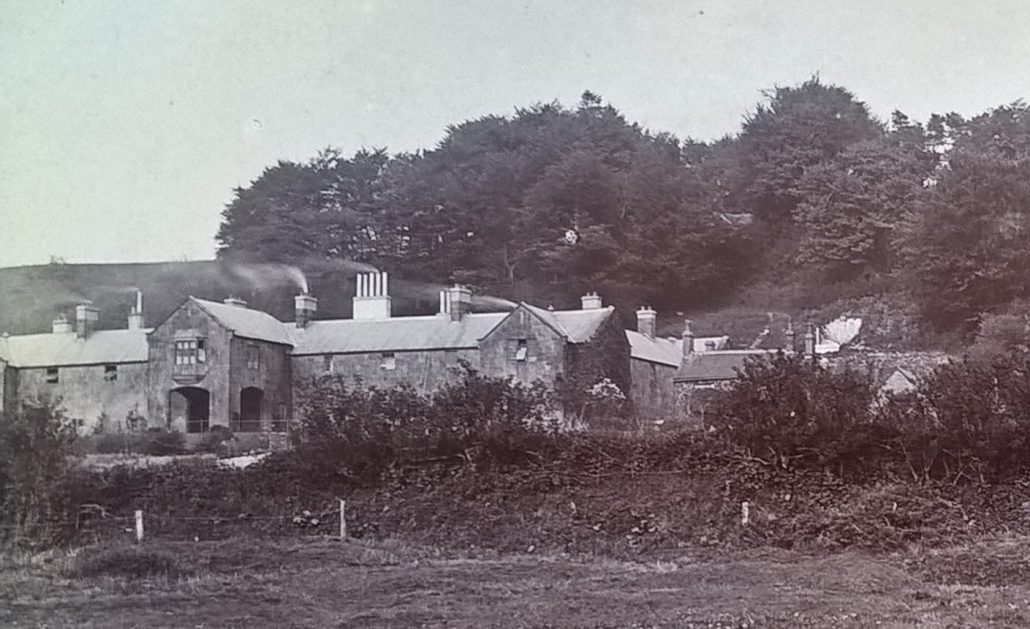Shaftesbury before 1914
In the early 20th century Shaftesbury was mainly a municipal borough and agricultural market town where produce, especially cheese and butter from the local area was traded. Saturday was Market Day, and the Market House, which ran from Bell Street to the High Street, was over 80 metres long. One of the entrances is now part of the Arts Centre, and the High Street entrance, now demolished, stood on the left-hand side of Lloyd’s Bank. Cattle were driven down the High Street to the market every week, and pigs were transported in netted milk carts so they could not escape. Farmers tied their cows to rails in the old cattle market, where the supermarket car park in Bell Street is now, and there could be up to a hundred horse- drawn vehicles in the town, bringing in farmers and their produce. The sale ring was in the centre of the cattle market, and John Jeffery & Son, the auctioneer, advertised sales regularly in the Western Gazette. There were three big fairs each year, in spring, August and November, for trading sheep, cattle, cheese and other agricultural products; they offered entertainment as well. The police station was in Bell Street where the library is now, and in 1911, Superintendent William Bowles had a sergeant and ten constables at his disposal. The police station provided cells, and accommodation for some of the policemen, including the superintendent. Superintendent Hussey took over in 1913, seconded from Dorchester. Courts were held weekly in Shaftesbury or Gillingham, and there were 20 county magistrates available to attend the petty sessions held at the Town Hall. The County Court was held once a month, again in the Town Hall, except in September. Public facilities included gas street lighting which served the top of the town, with oil lamps in St James and Enmore Green. Water was pumped from a large well on Barton Hill to a reservoir near the Semley Road, and distributed by gravity to most of the houses in the town. However the supply was turned off between 6pm and 8am, which caused some inconvenience for householders without a cistern. Most people in St James drew water from public taps. The fire engine station was in Bell Street, and was staffed by the captain, William Farris, a lieutenant and twelve men. Before the war, the ‘engine’ was in fact a horse-drawn hand pump. The horses used to pull it were kept in a field in Enmore Green, and time was unavoidably wasted as efforts were made to catch the horses and harness them to the pump. In a town with so many thatched houses this was a serious problem. There was a comprehensive postal service in the town, with mail dispatched several times a day, and up to four daily deliveries and one on Sundays. The main post office in the Commons was open from 8am to 9pm on weekdays, and there were sub-post offices in St James and Enmore Green. Postmen walked to Fontmell Magna, Stour Row, Margaret Marsh, Semley and other villages, and often rested in a hut at the end of their round, so they could collect letters on their way back to town. Public transport catered for those without their own carts, or people arriving at Semley by train. An omnibus ran to Semley station from the Grosvenor Hotel several times a day to meet most of the trains, and many of the Shaftesbury pubs hired out carriers for goods, especially on Saturdays, market day. In 1911 Shaftesbury Grammar School catered for seventy boys, twenty five of whom were boarders. There were three elementary schools, one in Bimport for about 320 children, one in St James and the third in Enmore Green. Cann also had an elementary school, which was outside the town boundary. The Girls High School accepted day girls and boarders and like the Grammar School, had a very good reputation.
Shaftesbury and District before 1914
The Market Town
St Martin’s Fair was the largest annual fair and apart from the usual animal and produce stalls, coconut shies, swing-boats and a steam roundabout were set up outside St Peter’s Church and the Town Hall. Shaftesbury Agricultural Society Horse Show was held each October, and was one of the most important such shows in the west of England.
In November the annual Chrysanthemum and Poultry Show was held in the Market House.
There was a wide range of shops and services available in Shaftesbury to cater for residents and all the local villages.
Public Services
A few residents had telephones, mainly businesses and wealthy private individuals.
The corporation swimming baths were on Barton Hill, and tickets could be purchased at the Town Hall. Men and women bathed separately.
Open spaces were provided for public use, such as Park Walk, Castle Hill and the newly completed Pine Walk.
Two banks served the town, the Wilts and Dorset Banking Company Ltd on the High Street (now part of Lloyd’s Bank), and the National Provincial Bank of England in the Commons (now the Natwest), as well as the Post Office Savings Bank.
Transport
Shaftesbury was a popular destination for cyclists, and there were several agents for bicycles in town, and a cyclists’ ‘hotel’ in Salisbury Street. The first cars began appearing in the early 20th century, and this change in vehicles resulted in better surfacing for roads. Until this time roads had been dusty in summer and muddy in winter. In summer the council paid for roads to be sprinkled with water to keep the dust down. Roads were surfaced with stones, which were broken by workmen with hammers, and then crushed flat with a steam roller, preceded by a man waving a red flag. Piles of stones were left around the town so repairs could be made as needed.
Schools








